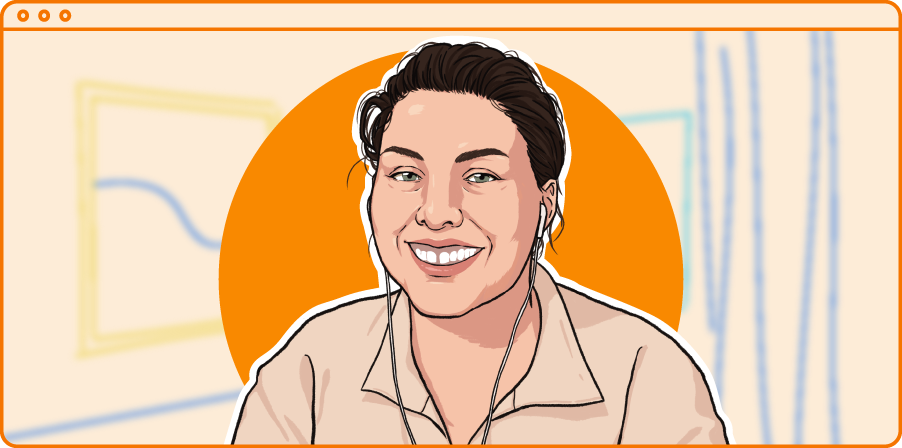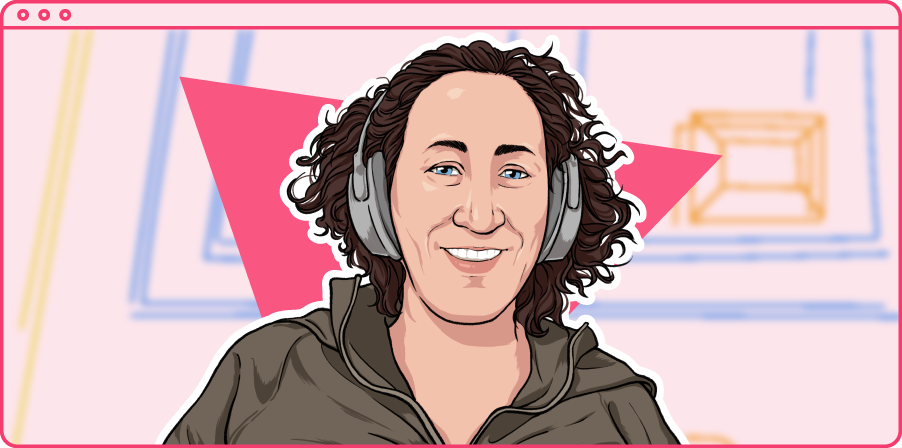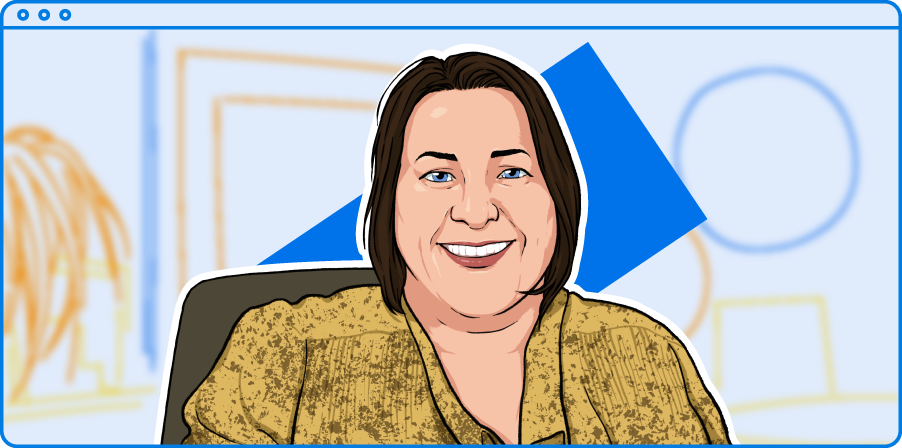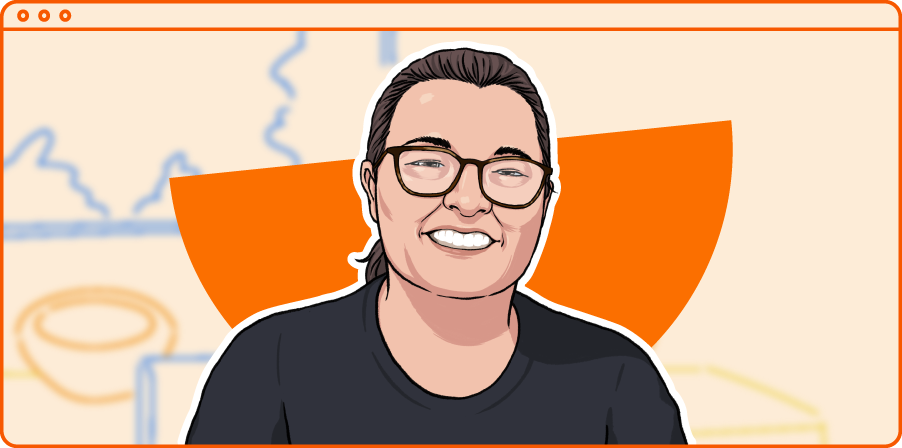Sara Fortier is the CEO and founder of Outwitly, a UX and service design consultancy, with a focus on digital services. They do everything from fuzzy front-end research and service design, to UX design, through to final UI design and working with development teams to implement. In addition to delivering consulting projects for clients, they also provide staffing of design talent on a contract basis.
In this interview, Sara talks about starting out as a solo consultant, and how her pregnancy pushed her to hire her first employee, and how that first employee was a catalyst for broader growth.

WORKOMICS: Let’s start by having you talk about Outwitly and what makes the company special.
Sara Fortier: We’re a women-owned and women-operated firm, which I think is super cool. There aren’t too many firms that are founded by women. We mostly work in the realm of digital service design. Often, we come in when existing systems aren’t work internally, and it’s creating a broken customer experience — or else a broken citizen experience, because we do a lot of work for government. We look at how the internal behind-the-scenes processes are feeding into the design of a digital application. That was how we started in 2016.
Nowadays, we also do a lot staffing. I never thought I would do anything in that realm. But staffing is really recruiting, and our expertise in UX and service design helps a lot — we know the roles and their nuances so well, and I’ve connected with so many people over my career that it’s been a natural fit.
WKO: Can we roll back to the clock to 2016, when you decided to start Outwitly. That was relatively early in your career. What drove you to make that decision?
SF: My formal training is in industrial design, and then I did my master’s of design. After that, I moved out to California, to be part of the tech scene. I learned a lot there, very quickly. You’re forced to. I had also worked for a big consulting firm and saw the billing rates for people. When I came back to Canada, I naively and optimistically thought I could make a lot of money if I billed myself out at a similar rate.
I incorporated a company right away, because although I was working by myself, I always thought Outwitly could be something bigger. I believed there was a gap in the UX design market at that time for consultants who could also bring a strategy and research perspective to the work. Design strategy is what I love and I’m very good at it, so it seemed like the next step for me.
My initial expectations for pay were totally ridiculous: I didn’t have an understanding of things like overhead and why companies charge the rates they do. Nevertheless, I had a few relationships with potential clients, so I started the journey of entrepreneurship. It was going well, and I’d get a bit of adrenaline every time I won a project. As I became established, I’d find myself booked all the time. I thought of growing my team, but it was really hard for me to let go of the control that comes from being the person who does all the design work. I couldn’t imagine handing over the work to someone else.
The tipping point came when I got pregnant. I was very pregnant and working 60 hours a week, and I realized I couldn’t do it. It wasn’t healthy or sustainable. That’s when I started hiring: one full-time employee and a part-time contractor in 2019.
WKO: Did you take a maternity leave? What did that look like?
SF: I took 2.5 months off. I was the bread and butter: if I wasn’t working, no money was coming into the company. There was no option of me not working, especially because I had brought on an employee and needed to pay her salary. COVID played a role too. My son was born in the fall of 2019, so I was coming back online in January of 2020. I hit the ground running with a bunch of potential projects, and then all of them went away. That was so frustrating.
Then I thought, “Wait a second. Digital transformation is essentially what we do. We are experts at the service design and UX piece that governments and companies really need right now.” Given the type of work that we do, COVID worked in our favour. Demand just exploded. People started asking me if I could work full-time. I couldn’t, but maybe I could find someone who could. That worked a few times, and I realized it could grow a bit more. The recruitment and staffing grew from there.
WKO: Within your business you now have two different models: staffing and more traditional consulting projects. How do those two different models complement or compete with each other?
SF: With traditional consulting, you work together as a team and you have direct oversight over what everyone is delivering. With staffing, you have no direct oversight, so how do you make sure you’re delivering the same quality, being responsive, being action-oriented, being kind? The contractors are not necessarily Outwitly employees, and they don’t know the Outwitly culture, but you’re putting them under the Outwitly name for these different clients. We’ve started to really hone in on who we’re bringing into our contractor world, so they are people aligned to our values who can be ambassadors for Outwitly.
WKO: It’s an interesting balance. You’re talking about maintaining the Outwitly brand for clients, but it strikes me that you have to have a really strong brand for your potential employees and contractors.
SF: It’s so competitive. There are so many other recruiters out there looking to staff the same roles. Without a brand, all you can compete on is price — length of the contract and how much you’re going to pay. Top-talent contractors are inundated with messages from recruiters. How am I getting them to pay attention to my message on LinkedIn over someone else’s? We apply service design internally to all the touchpoints the contractors have with us. Because of our work on the consulting side, they feel like we ‘get’ them, so they’re more likely to go with us.
We also invest in resources for these contractors so they’re not just out in the ether by themselves. We create a community for them, which is where Workomics comes in. We train them, we coach them, we think about their invoicing processes. We think about the supports people might need going from a full-time employee to a contractor. We really try to think about the end-to-end journey contractors are on with us, so that we can compete on more than just rate.

WKO: You’ve said that pregnancy was the thing that pushed you to hire your first employee and start to scale the business. I’m curious about how the role of motherhood intersects with the business owner role. Both of those things are “always on” by their very nature.
SF: I would say it’s pretty exhausting, but I’m able to compartmentalize. If my son is in daycare then I’m not thinking about him; I’m thinking about work. When he comes home, I try really hard to move work out of my brain for those few hours. And then sometimes I have to go back and do more work after he’s gone to bed. The hardest weeks are when he’s sick and not in daycare.
When he is in daycare for eight hours, I have become so efficient with my time. There’s no dilly-dallying. I’m trying to grow the business, not just maintain it, so for me there’s no downtime. Growing a business requires constant learning: always challenging your own ways of thinking. If I want to scale the business, I can’t work the same way I have in the past, where I’m involved in everything. For me, that’s a mindset piece: Can I relinquish control to other people? Can I trust them enough to fully move away?
Remember: I only hired my first employee because I was essentially forced from a biological perspective. But hiring her was the catalyst for growing the company, scaling it, becoming more profitable. I realized that if I have another person doing a piece of work, I can spend that time doing something else that’s even more valuable. Not everything gets done the way I would have done it, and that is OK. They got the job done and the client was happy. But it does take practice and forcing yourself to do it. I’ve been working with a business coach, and she’s been wonderful helping me when I’m stuck on that kind of thing.
WKO: That’s a nice segue into the relationships that help nourish the business and nourish you as a business owner. It can be a fairly solitary existence for someone who is both founder and CEO.
SF: I’ve invested in some form of business coaching every year, and it’s become more valuable over the years. The coaching has been helpful as a safe place to unpack feelings or worries, and of course she supports me with the business model as well. Having good family support is helpful too. My parents are entrepreneurs, and so I would call my mom to tell her about a stressful thing that happened. And she would say, “Remember everything is going to be fine. There will be more work around the corner.” Having other entrepreneurs who are older than you, who have been through things, who can reassure you — for me that’s been really helpful.
Then I think having a supportive spouse is important, especially as a female business owner. You need someone who’s going to do all the other things that are required in being a homeowner and a parent. My husband works, but not to the same extent that I do, so he has more hours in the day to dedicate to house care and childcare. He takes my son to daycare so I can have an extra 45 minutes in my workday.
Otherwise, I would say there’s two other things. One is having some of the people who work with you be really in it with you. They can understand and commiserate, be your partners in crime. The last thing is a broader community of entrepreneurs, if you can foster that. I love to connect with other business owners who are mothers, who understand some of the unique challenges of being a business owner and a parent. But it’s hard to get those relationships solidified — there’s never enough time.
WKO: Growing up in a family of entrepreneurs, did you always want to run your own business?
SF: No, not always. As a sassy teenager, I remember telling my dad, “I don’t want to own my own business.” Later, I realized how much independence and different ways of thinking they instilled in me. It almost would have been impossible for me not to be an entrepreneur. As an employee, I would go in and ask “why are we doing it like this? It doesn’t make any sense.” I think I was always nice about it so it would work out for me as an employee, but it was very clear in my head that everyone else was doing it wrong and it should have been done my way!
WKO: How do you define success at this moment in time? And how is that different for Outwitly vs. Sara?
SF: I struggle with this. Outwitly is me, but it’s also an asset that is other than me. I am working on separating myself from the identity of Outwitly, so the business can thrive and scale. It’s also necessary to be a whole human being. My personal sense of self-worth can’t be dependent on how successful Outwitly is as a business. So, for me as a person, I think success is not working so much: having time to think, feeling happier, more relaxed.
For Outwitly, it’s not going to be the most altruistic answer. I like looking at the numbers and I like seeing how we’re doing compared to last month or last year. I know what I want to achieve in revenue. We’ve already hit multiple millions and I want to increase revenue by 2.5x next year. I think that’s achievable based on contracts and work that we have. A few years from now, I want to get to $20-million.
WKO: That’s amazing. I was reading an American report, and only 2% of women-owned businesses exceed $1-million in US dollars of revenue. So congratulations.
SF: Thank you. Before I hit $1-million in revenue, I read the same stat. And I just thought, “F**k that. I’m doing it.” It’s funny how things you read can motivate you. At the same time, I was reading a book about a woman who had achieved $1-million in revenue. I thought, “Ok, you did it; I can do it.” The 26-year old version of Sara never thought she would get there. Sometimes you just need the example set in front of you from someone who’s done it before, to let your brain know that it’s possible.
Our other ideas worth exploring
Investing for long-term sustainability
Joelle Faulkner, CEO and Founder of Area One Farms, talks about building up her own investment firm, focusing on Canadian agriculture.
Fostering connection, community, and care
Jill Curran, owner of two tourism-based businesses, talks about building layers of care and community into clients’ travel experiences.
Changemaking and digital transformation
Briana Sim, CEO and Founder of SimpliCity, talks about using digital transformation as an avenue for broader changemaking in government



